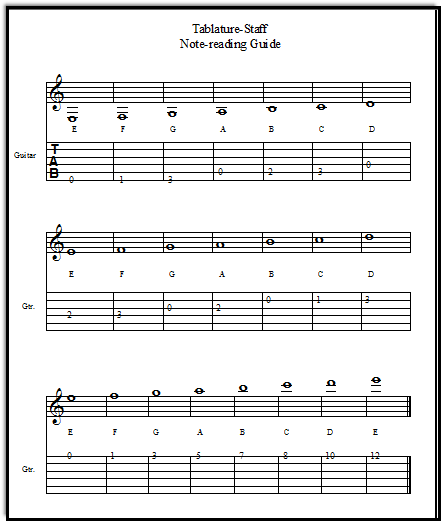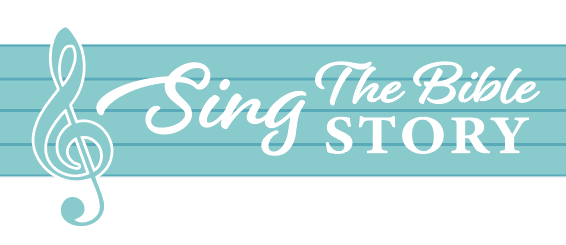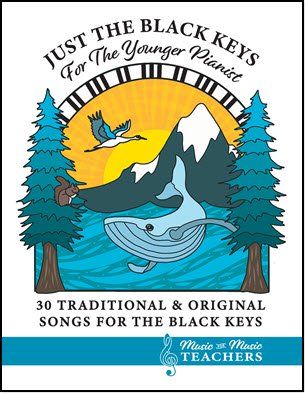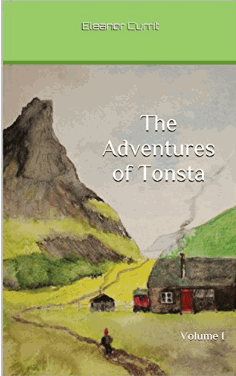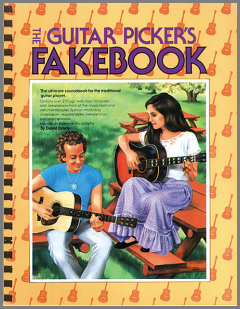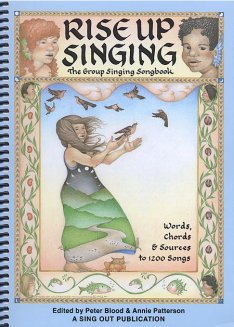Piano Tablature /
Guitar Tablature
Piano tablature is really called a "staff."
Piano players usually read two staffs as they play -- one for high notes (treble staff, for the right side of the piano keyboard) and one for low notes (bass staff for the left side of the keyboard).
Only one staff is needed for guitar players, the treble (or top) staff.
The 3 charts below show how the treble staff matches up with guitar tabs notation.
Please scroll down the page for the download links.
What about the sharps and flats?
This set of notes does not show accidentals; only the plain notes. For showing your students sharps and flats, print out the PDF file farther down the page...
Won't my guitar students be stuck forever reading guitar tabs if I start them that way?
Although I write up songs for my students with guitar tablature notation, my GOAL is for them to become standard notation -- treble staff -- readers.
I have found that my guitar students (who ALWAYS prefer to play by ear or with "tabs"/tablature, without fail!) will plug along through their notereading book without too much complaining, as long as they also have guitar tablature music to play.
The method books typically add staff notes slowly... and months go by, with the notereading method book carefully adding one note after another, starting usually with the open G or B string and branching out from there.
Finally, two-thirds of the way through the book, the kids are reading down into the ledger notes below Middle C.
Page 1 of a "notes with sharps & flats" guide:
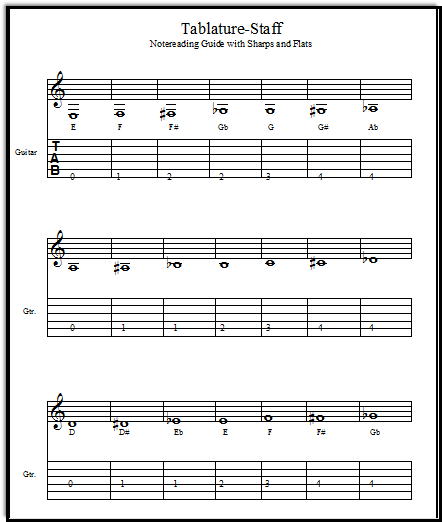
Please scroll down the page for the download links.
Yay!!! They have really come a long way!
But how solid is their note-reading, really?
Suddenly, the book's authors remember that we haven't visited treble B, C, and D for a while, so, out of the blue, we have songs thrown at us again populated with these old notes as well as the newer notes. And my students stumble around and say, "I've forgotten what that note is!"
Oops! We should have been reviewing. This is definitely my fault, not the student's fault!
So now, I try to build one review song from earlier in the book into each week's lesson, and their knowledge will stay more solid.
...and these notation charts!
But also, I keep these piano tablature/guitar tablature notation sheets handy for students, at the beginning or end of their music notebooks, along with a piano keyboard sheet.
Page 2 of the notes with sharps & flats:
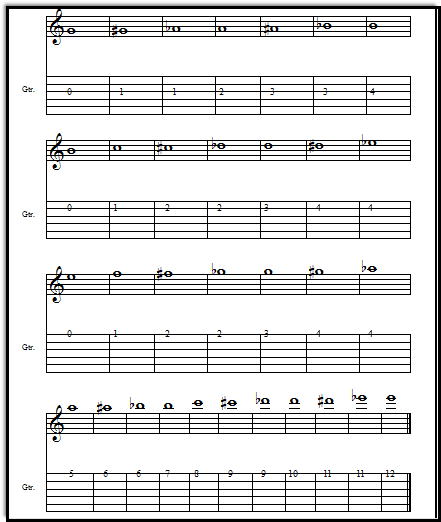
Please scroll down the page for the download links.
These are only the basic or default frets for the notes -
These charts show THE MOST USUAL guitar tabs for each piano staff note- what is known as FIRST POSITION (where the left hand's 4 fingers naturally lie when finger 1 lays in fret 1, finger 2 in fret 2, etc.).
One of the tricky things about playing guitar comes from the nature of overlapping notes from string to string; 2 or 3 adjacent strings can all play the same note, though on different frets, but these different fretted or open "sounds" will all be represented by the same note on a staff!
That's one nice thing about tablature - it tells you exactly which fret best accomplishes that sound, in that situation!
The links for the tablature / staff notation charts:
Piano tablature/guitar tablature notation
Treble staff with sharps and flats with tablature notation
Dianna:
Your website is a light in the darkness. THANK YOU for all you do in helping to spread the love of music. It matters!
Recent Articles
-
Auld Lang Syne Sheet Music PDFs: for All Instruments & Singers!
Auld Lang Syne sheet music for New Year's Eve & other gatherings! Piano arrangements, guitar tabs, & lead sheets with chords in many keys, for all singers. -
Favorite Christmas Songs: Duet Vocal Sheet Music
The best duet Christmas songs are those ones you knew & loved as a child! This set of 14 "a capella" carols arranged for 2 voices is just right for caroling! -
"Walking In the Air" Piano Music from The Snowman
This sparkling piano arrangement of the main musical theme from The Snowman will win your students' hearts and imaginations, too, with its soaring beauty! -
Moonlight Sonata: How to Play Beethoven's Lovely Piece
Moonlight Sonata: How to play this beautiful but difficult piece full of black keys & triplets? With larger-than-usual notes, & letters inside the note heads! -
Classical Piano Sheet Music: a Set of Introductions
Classical piano sheet music - Fun, mostly one-page intros! Bach, Beethoven, Mozart & more - see what's new!
Interested in songs from the Bible for your students or church? Check out my other website, SingTheBibleStory.com!
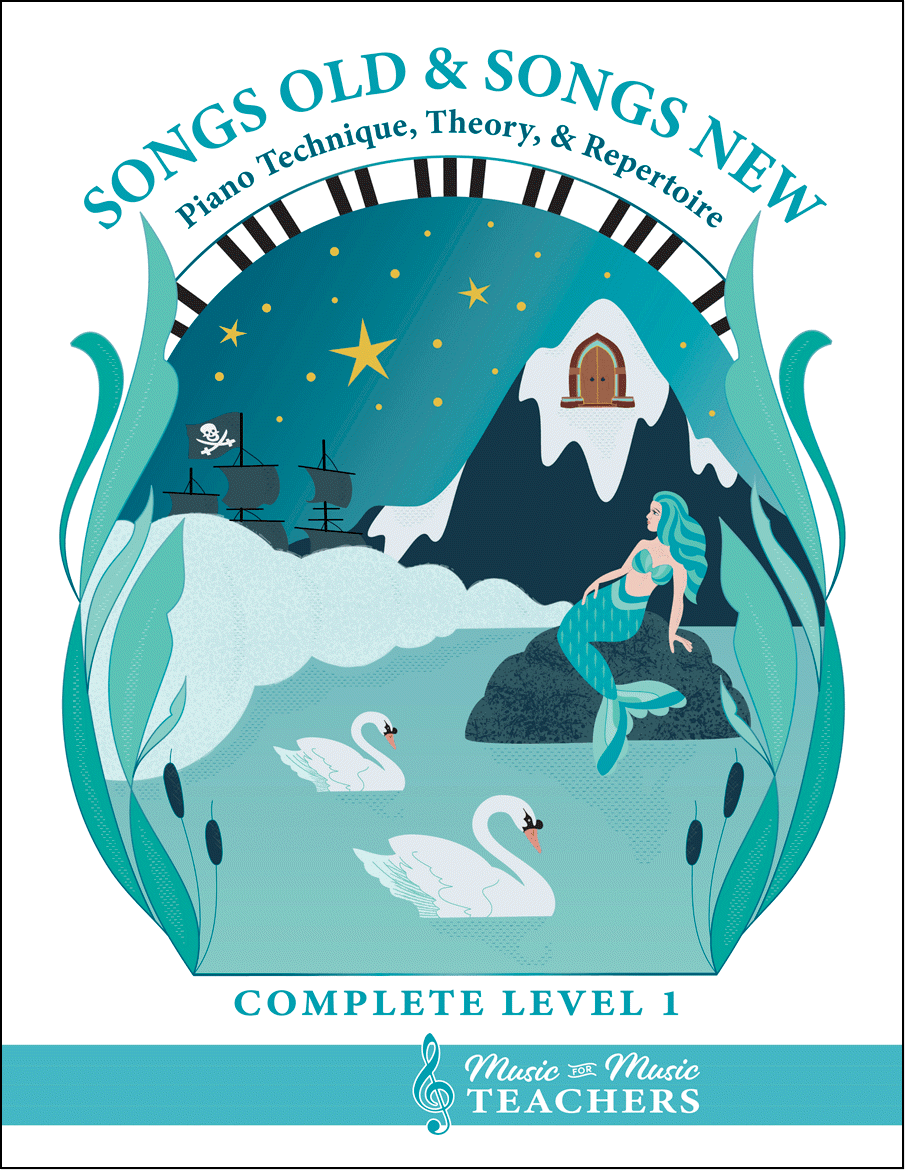
All the first-year material I give my beginner students.
Piano keyboard sheets, scales, chords, note-reading exercises, and over 256 pages of music!
Music-for-Music-Teachers.com is a participant in the Amazon Services LLC Associates Program. As an Amazon Associate I earn from qualifying purchases.
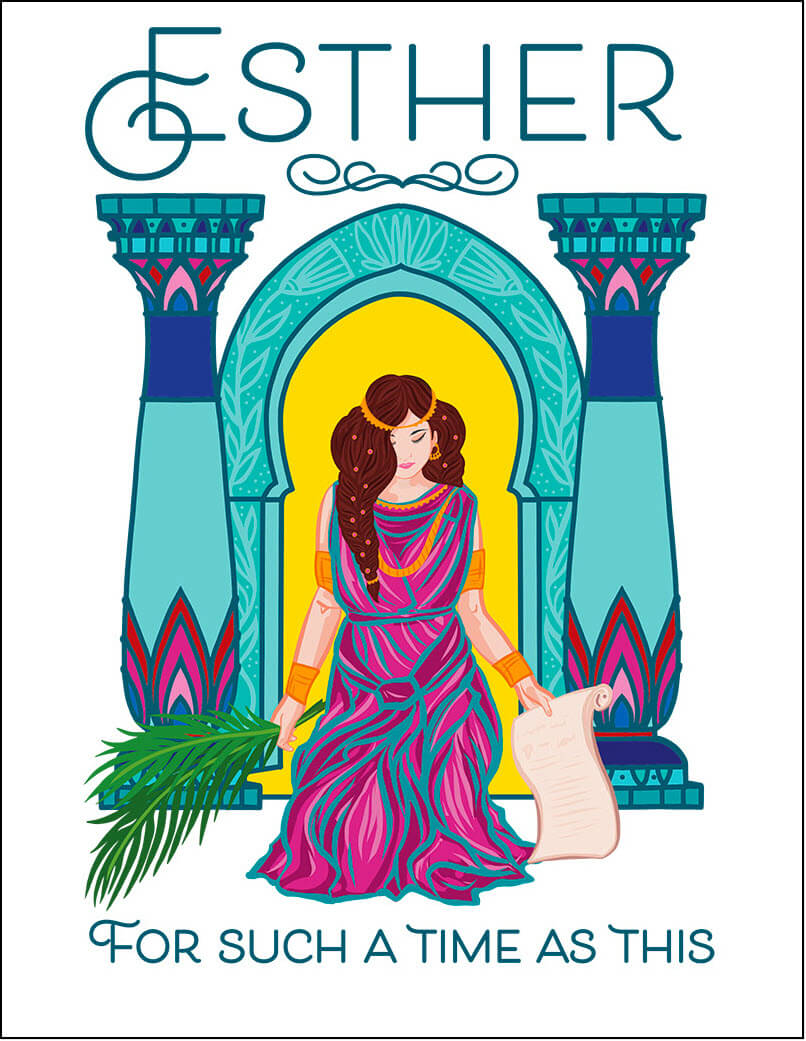
This beautiful song book for piano & voice "Esther, For Such a Time as This", available as a digital download, tells the riveting story of the time when Jews in ancient Persia faced a foe named Haman, and how a brave young queen risked her life to save her people.
A good choice for a singing story-teller, an operatic group, a short theater production, or a class of children!
This book is also available from Amazon as a paperback.
Music-for-Music-Teachers.com is a participant in the Amazon Services LLC Associates Program. As an Amazon Associate I earn from qualifying purchases.
This book is available as a digital download from this site. Visit this page to see some free examples from the book.
It is also available from Amazon as a paperback!
This is the perfect easy start for little pianists.
And when they start reading white-key notes on the staff, this is a fun easy resource to say each week, "Choose a new black-key song at home this week and figure it out to show me next lesson!" They will be spending more time at the piano.
Music-for-Music-Teachers.com is a participant in the Amazon Services LLC Associates Program. As an Amazon Associate I earn from qualifying purchases.
A perfect read aloud storybook
for little boys or girls.
The Adventures of Tonsta highlight the travels of a very young boy with a good heart, who goes about helping folk in trouble.
With a red cap on his head and a sack of tools slung over his shoulder, Tonsta seems to meet people in distress wherever he goes.
Lots of trolls in this book - including one who gives him a Christmas gift!
Music-for-Music-Teachers.com is a participant in the Amazon Services LLC Associates Program. As an Amazon Associate I earn from qualifying purchases.
Matt:
THIS SITE IS AMAZING!!
I've been teaching guitar for about 5 years now, and I've only just found your website! (I could really have used it 5 years ago) :-)
I teach at primary schools every week day for about 4 hours, so the beginner tabs you have are ideal. Thank you so much for your hard work getting these on the web, you have made many children very happy!!
Christine:
Thank you so much for this site! I have just started teaching some really keen Y6 boys who want to play Scarborough Fair, and your version is perfect. I will now go and look at what other goodies you have!
Comments
Do you have a story or a question about teaching guitar? Do you think it is a hard instrument for beginners, or easy? What have been your challenges?
Please note that all comments are moderated, and will not appear until I have approved them. Also, IF YOU ARE ASKING FOR MUSIC THAT IS NOT IN THE PUBLIC DOMAIN, YOUR REQUEST WILL BE IGNORED. That's pretty much any music written in the last 75 years...
About the Author

Hi, I'm Dana! (Say that like "Anna".) I'm the owner of Music-for-Music-Teachers.com, and a newer site, SingTheBibleStory.com.
Like some of you, I've been playing the piano since early childhood, and have added a few other instruments along the way, plus an interest in arranging and composing music.
You can find out more about me and the reason for this website at my About Me page.
